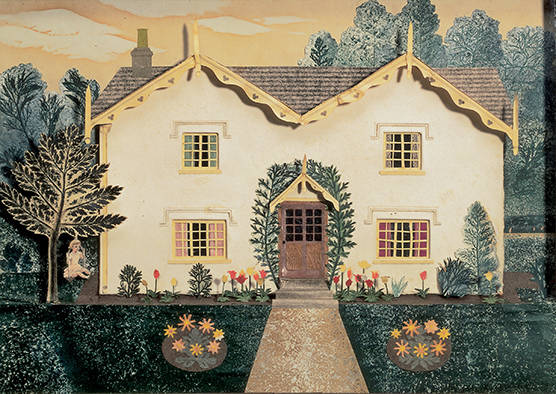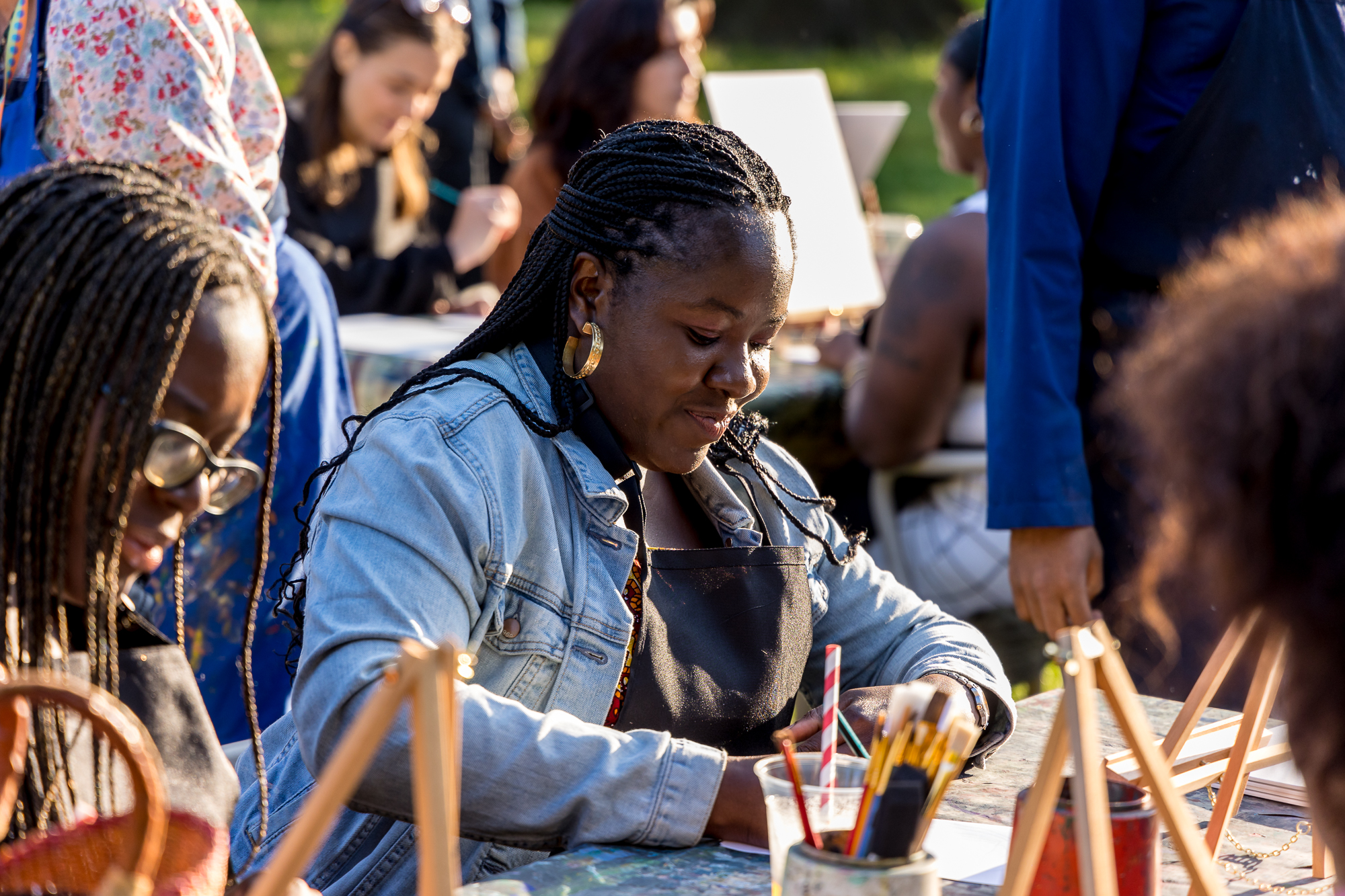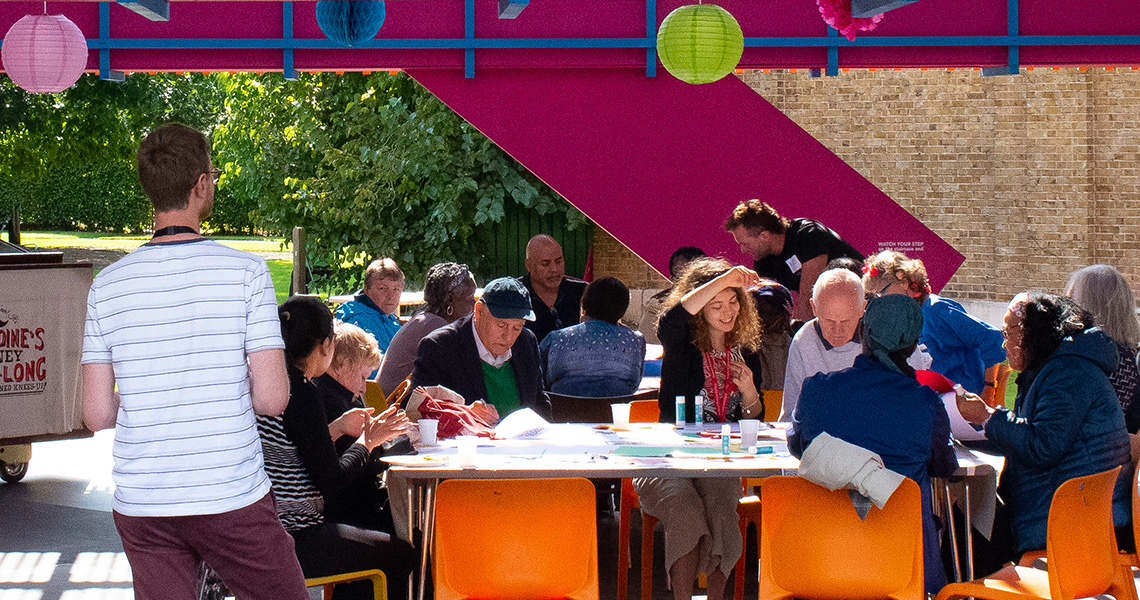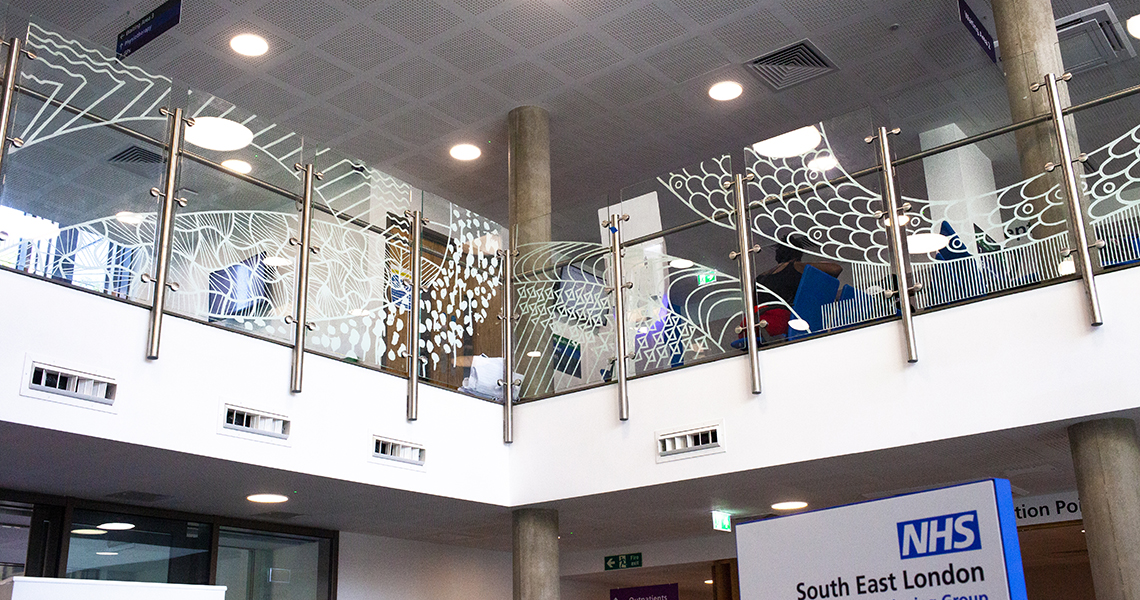What impact does art have on wellbeing?
For decades, artists and organisations have understood the value that art can have on health and wellbeing. Frida Kahlo famously began painting as a way to entertain herself whilst she recovered from an accident. Whilst, following the hospitalisation of her daughter, Barbara Hepworth created sketches of surgeons as a way of showing admiration for their skill. We’ve even seen this theme thread its way through our latest exhibition, where in her darkest moments, the artist Tirza Garwood used art as a way to spark joy. From the National Portrait Gallery’s Hospitals Programme, to the (similarly named) Paintings in Hospitals scheme, in the UK today many organisations are striving to blend both art and health. All share the belief that creativity is a necessity for a rounded life.

Tirzah Garwood, Villa at Walton on Naze, 1948, leaf print, paper collage set in box frame, private collection.
In 1942, whilst the war artist Eric Ravilious was marked as Missing in Action, his wife, Tirza Garwood, received this news not long after recovering from a mastectomy. Balancing grief with new responsibilities as a widowed mother definitely would have taken its toll, and it was a couple of years before Garwood began creating art again. In the early forties the artist took up painting and collage with childlike enthusiasm. From the cheerful leaf printed collage of The Tent (1944), to the relief sculptures of Pure Cream Ices (1945-6) and Villa at Walton on Naze (1948), Garwood used art to escape to new worlds.
This period shows the artist using creativity as a form of respite during this challenging time in her life. It therefore does not seem surprising that years later, when her cancer had returned, that she also took to art once more.
In 1950, in her final year, Garwood stayed within the nursing home, Copford Place in rural Essex where she produced over 20 oils. Inspired by her immediate surroundings, these captivating works turned domestic scenes into fantastical, surreal paintings, all imbued with the same wit and character of her earlier pieces.

Tirzah Garwood, Spanish Lady, 1950, oil on canvas, private collection.
Importantly, her final moments were described in her journal as ‘the happiest year of her life’ and Garwood delighted in spending time transferring her excitable imagination onto paper. From the surreal and whimsical Spanish Lady (1950) to the mischievous cat portrait of Erskine Returning at Dawn (1950), Garwood created numerous paintings filled with joy. Laughter resonates throughout each piece and plainly displays the positive influence art had on the wellbeing of someone who was critically ill.
Garwood was using art as an antidote during a huge period of change for the UK. In 1948 the NHS was established, and Post-War Britain was rebuilding itself as a fairer and more inclusive society. Fast forward a decade to 1959 and the Paintings in Hospitals scheme was established, which began the conversation between art and its impact on health. Meanwhile, in 2019 the National Arts in Hospitals Network was established as a way to share knowledge between the multiple arts managers who work in our hospitals. Over the past few decades art has slowly embedded itself within healthcare practices and the rewards can’t be ignored.

A whole host of research conducted by our Department for Culture Media and Sport (DCMS) shows that cultural engagement brings with it benefits worth around £8bn. Decreased dementia risk and improved mental health are said to contribute towards this figure. In fact this report has shown that engaging with the arts, whether that be through attending a concert, seeing a play or visiting an exhibition, has seen improvements in ‘frailty, depression and dependence on medication’ (The Guardian 2024). Not to mention the lasting impact it has on quality of life.
Dulwich Picture Gallery is one of the many arts organisations who understands the value creativity can have on health. In 2021 we announced the Creative Arts Partnership, which has seen us work with the Tessa Jowell Health Centre (TJHC) in East Dulwich to continue exploring the relationship between art and health. Formally known as the Creative Arts Partnership, ourselves and TJHC have worked alongside NHS South London CCG, as well as numerous cultural organisations, GPs and artists to devise a programme that supports the physical, emotional and mental wellbeing of Southwark’s residents.

The partnership focuses on three key areas: enhancing the healing environment, integrating creative programmes into health practices and connecting people with local community services (also known as social prescription).
Since announcing the partnership, we have commissioned four artworks over a two year period for the health centre. These include The Health Centre’s Quilt (2021) by Bamidele Awoyemi, Farouk Agoro and Livia Wang; Bubble Dreams (2022) by Carolyn Defrin and Paul Burgess; Osiris (2022) by Rafael Klein; and Moving Out (2022) by Rachel Davies and Daniel Saul. From exploring the beauty of community, to the tranquillity of spending time in nature, the following artworks shed light on the multiple ways that art can improve our everyday lives.

Through a number of workshops created for the health centre’s community, TJHC have been working to include creative classes within their medical practice. Feedback from practitioners of the partnership had seen a huge improvement in the personal wellbeing of participants. Those who attended workshops, classes and more appreciated being connected to others, and noted feeling happier overall. A recent example includes a breathing workshop run by the City of London Sinfonia with TJHC which was made available to Southwark, Lambeth and Lewisham residents who had been referred by a GP. We look forward to seeing how this ongoing programme positively impacts residents in the future.
The recent DCMS report, evidence from the Creative Arts Partnership, and even anecdotes from Tirza Garwood herself shows the impact that creativity can have. We look forward to exploring this further and hope that our partnership with the Tessa Jowell Health Centre can inform other settings on the many ways that art can be used both in transforming healthcare spaces and improving patients’ wellbeing. We believe art is a necessity not a frivolity.
Don’t miss the chance to relax and unwind at our latest exhibition, Tirza Garwood: Beyond Ravilious, or view our upcoming programme. Discover more information about our partnership with the Tessa Jowell Health Centre here.
